You are currently browsing the tag archive for the ‘tree planting’ tag.
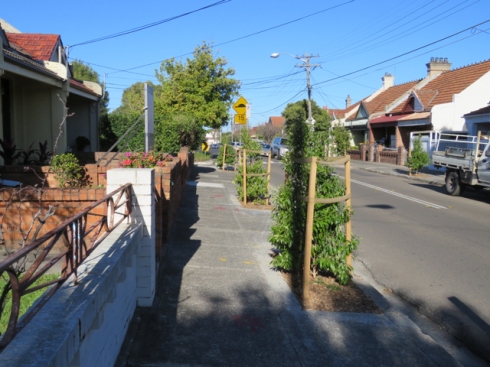
Concrete removed and new street trees in Calvert Street. You can see two other new trees across the road.
Calvert Street Marrickville would be considered a street that has “enough” street trees when comparing with many other streets in the former Marrickville LGA. Therefore, I was really happy to drive down this street earlier this week & see lots of substantial-sized newly planted street trees. I was with a friend who is an Arborist & between us there were lots of exclamations like “ooohs,” “wow” & “look at that.” Being keen on trees makes one get excited by things like this. 🙂
Today I went back on my bicycle to have a closer look & was pleased with what I saw. Inner West Council has depaved sections of the footpath on both sides of the street & planted street trees in places where there were none for at least two decades, but likely much longer.
Council planted 27-28 new trees to fill in gaps & to add in places where they tend to leave empty.
Calvert Street looks so much better for these new trees. In 7-10 years, the residents will be really benefiting from the greening of their street.
The community will also benefit as Calvert Street will be much more pleasant for pedestrians. Being a street off ‘Town Centre,’ plenty of people walk this street to get to & from the shops.
New street tree plantings in Calvert Street have a history of being vandalised, so I am very pleased that Council did not capitulate to the vandal & continued to plant street trees. None of the new trees have been vandalised that I could see, so perhaps the vandal has given up, got educated, developed a social conscience or moved on. Any of these is a win for the community.
There seems to be a change this year in where trees are being planted & with the density of planting, which I think is wonderful.
If the Inner West Council’s plan is to plant all our streets like this our urban forest canopy will increase & so will this community’s health & quality of life. There will be less respiratory diseases, such as asthma & less heart disease with fatal heart attack.
Trees help lower stress & help depressed people feel happier. Trees also lower crime rates, lower noise pollution, act as a wind buffer & help catch stormwater. Powerbills should drop significantly, as will the urban heat island effect. Trees also sequester CO2 making them a vital component in mitigating climate change.
These are just some of the benefits trees provide for residents. There is no doubt that trees make streets nicer & healthier places to live. Shade is a valuable amenity these days.

New trees wherever there is a space. Also depaving and plants added around the trees. This always improves a streetscape.
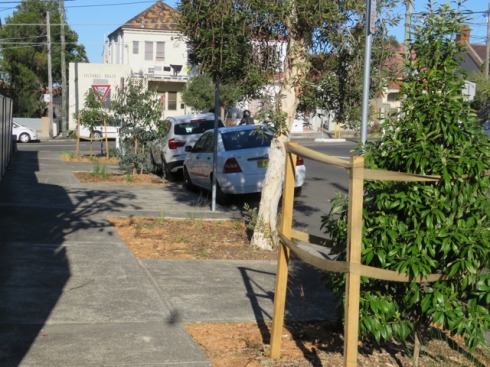
Even adding more trees in areas where in the past, one was seen to be enough. Great to see so much concrete removed too.
I’ve always known this as Tempe Dog’s Park, but on google maps it is Tempe Park. It is the one on the hill beside the Tempe Golf Range & Maritime Container Services. It is a great place for photographers to get a photo of stacked shipping containers with airplanes flying overhead – at least I think so. Add a dog or two & it becomes really interesting.
This park is in dire need of trees in my opinion, so it was great to see 7 new trees planted next to & close to the container area. I hope Inner West Council decide to plant more trees here in the future. I think it would be good to have some trees in the middle of the park to add beauty & also provide shade for the park users. All other trees there apart from the seven new trees are behind wire fences & not really providing much amenity for the users of this park.
Anyway, it is great. The new trees once grown will provide a nice shady place where you could have a picnic & allow your dog/s to run around & play.
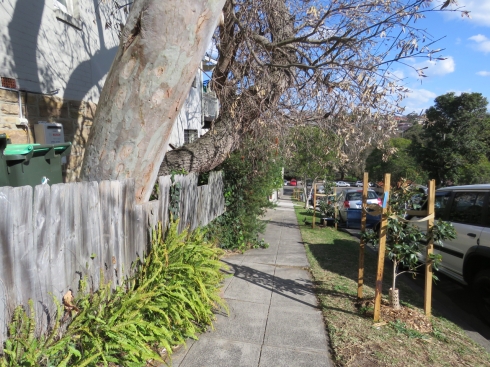
Showing a line of new trees planted towards the end of Livingstone Road. From nothing to leafy will be really nice. I also love that the owners of the two trees on the left made modifications to their fence to allow them to keep the trees.
I am impressed to see so many newly planted street trees being planted to actually fill in streets, where previously the number of street trees remained stationary for many years.
It looks good to see street trees planted closer together. Unless they are badly or over-pruned, the density of planting will also create decent shade once these trees grow larger & shade is much needed on our streets.
Livingstone Road Marrickville South is not one of the streets that I felt was desperately short of street trees. While I consider there are very few streets in the overall percentage in our area that don’t need at least one tree, Livingstone Road has a good number of taller trees & a relatedly good canopy when compared with other streets. Therefore, I was really pleased to see that the Inner West Council has planted new street trees much closer together, every 5-7 metres or so depending on conditions like driveways.
I was also pleased to find a tag stapled to a stake that told me these new trees are Luscious® Tristaniopsis laurina.
This tree is an Australian native that is similar in appearance to a Magnolia, which is a very popular tree, so people should like it. It grows to 7–12 metres tall & 5 metres wide at maturity, though this cannot be taken as a given due to growing conditions & importantly, pruning practices.
The leaves are large dark green & shiny with red or copper-coloured new growth. The bark is a port wine colour that peels to reveal a cream colour. Yellow sweetly perfumed flowers are produced in summer attracting bees, butterflies & other insects.
It seems that wherever I drive I see new trees & this is a change from previous years when I started being observant of these things. Thank you Council.

Two dead street trees right next to each other in Marrickville – notable because they are beside each other.
My last post was about the NSW government’s ‘Five Million Trees’ initiative. See – https://bit.ly/2H2IEkz The aim is to increase Sydney’s existing tree canopy from 16.8% to 40% over the next 12 years at a cost of $37.5 million over four years.
Fortune had it that I came across a long & detailed article from Scenario Journal titled, ‘How Many Trees Are Enough? Tree Death and the Urban Canopy’ written by Lara A. Roman. https://bit.ly/2K1G1gC
The article looked at tree survival across US cities. Research has found that, despite concentrated campaigns to increase the urban canopy in many major US cities, the canopy cover is actually declining. This is of major concern considering the extra pressure we have from increased development, a changing climate & its associated urban heat island impacts.
Three questions were asked –
- “With major new planting campaigns, how many of those trees will survive for decades, reaching a mature size at which their environmental and socioeconomic benefits are greatest?
- How many trees are enough – that is, how many need to be planted to make a lasting impact, and meet a city’s canopy cover goals?
- What are the implications of future tree death for managing the urban forest, in terms of cycles of tree removal and replacement?”
“For street trees in New York City, eight to nine years after planting, 26.2% were dead. For a yard tree give-away program in Sacramento, five years after planting, 29.1% had died, on top of 15.1% that were never planted by residents. For these yard and street tree examples, over a quarter of the trees planted died within the first five to nine years, and furthermore, for the tree give-away, some trees never made it into the ground.”
As part of their 5 Million Trees initiative the NSW government plans to give away 15,000 trees to people who are building homes in new land release areas in Western Sydney. I wonder how many of these trees will actually be planted. I don’t know about you, but I have bought plants from the nursery & left it too long before I put them into the ground. One can realistically expect that high numbers of these giveaway trees will not be planted in western Sydney. Will these be acknowledged, or will they just be written up as a successful addition to the urban canopy simply because they were given away?
The Inner West Council has given away trees for the past two National Tree Days & I applaud them for this. It would be interesting to know whether Council has gathered information about how many of these trees made it into the ground & how many are still alive today?
The article notes that in the US there is very little in regards to monitoring & follow-up with tree planting campaigns & calls for a nationally coordinated monitoring network.
The author then cites the common belief that street trees live on average for only 7-years & a maximum of 13-years. Apparently, this belief was formed decades ago where a questionnaire was sent to urban foresters “asking the local experts to estimate the typical tree lifespans in their cities.” The author describes this as “overly pessimistic.”
One only need to look around our own suburbs to know that there are plenty of streets with street trees that are 70-100 years of age. Generally, these are QLD Brushbox or Fig trees.
A study to understand the change in the street tree population of West Oakland in the US looking at annual tree planting & tree deaths found that the annual mortality rate was 3.7%. Most of the tree loss came from newly planted trees with a trunk of 7.6cms (3 inches).
“Extra vigilance during the establishment phase, in terms of maintenance and stewardship, might have the most payoff for ensuring planting survival, and thus achieving larger canopy objectives.”
“Planting a few hundred trees, or even a million, does not automatically translate into an increase in the overall tree population over the long-term. To increase population levels, the survival and planting rates have to out-weigh losses from tree death and removal, including both old and young individuals.”
I think this article brings up serious issues concerning increasing the urban forest. I’ve noticed that street tree removals post Marrickville Council’s Tree Inventory meant that for at least 3-4 years the urban forest numbers stayed relatively the same. With 1,590 streettrees to be removed from 2013, planting around 400 new trees a year meant that making up ground was slow.
I have noticed that a lot of street trees have been removed in the last couple of years. Since Council does not report the removal of trees 5-metres or under & since 49% of our street trees were found to be 5-metres or under, we have no idea where street tree numbers are at now & no ability to calculate this ourselves. The Tree Inventory was costly, so I doubt we will have a new one done for many years.
Increasing the canopy means not the number of trees planted, but the “percentage of total ground area; for example, at 50% canopy cover, half of the total ground area is covered by the vertical projection of tree crowns.”
This has an impact on the way Council prune street trees as well. Continuing to remove side branches that serve to make the tree canopy fuller & produce longer periods of shade is counterproductive – unless it is required for safety reasons like branches over the road affecting passing trucks as an example. However, you only need to look at the street trees around you to know that many street trees are pruned to have no side branches.
Council’s policy of no tree branches 2.5-metres (8.2 feet) above a footpath pretty much ensures that the footpath will have no shade except for perhaps an hour when the sun is in the right position.
The Five Million Trees initiative may result in significant changes with tree planting & reporting. It would be good if this information is available to the community should they be interested. Hopefully, outdated ways to manage street trees get dumped & our urban landscape becomes green & flourishing.

One of two new trees planted close to the edge of the rover bank in Kendrick Park. These will provide nice shade & food for wildlife. Discovery Point Wolli Creek looms over us. The wide angle lens flattens the height making the buildings seem less imposing than what they are. Building has not finished yet.
Last weekend we took a bike ride from Mackey Park to Kendrick Park & on to Tempe Reserve. For various reasons, it has been a number of months since we last visited Tempe Reserve.
It was great to see two new trees planted close to the riverbank at Kendrick Park. These will replace the trees removed back in 2011 that were in this position. Shade here will improve the amenity of the park, as well as add beauty & habitat/food for wildlife.
Looking across to the ever-increasing development at Discovery Point Wolli Creek is perhaps a look at the future for Marrickville & Dulwich Hill. I certainly find it strange to recreate under the eyes of so many just across the river. I think this is something we are all going to have to get used to.
It was also wonderful to see that all the new trees planted near to the Princes Highway at Kendrick Park are growing well & have not been vandalised. This is unusual these days.
Unfortunately, Fatima Island is holding on by a thread. There are perhaps three trees left. Personally I feel sad that this island is likely to be lost. It is a wonderful refuge for waterbirds & only one of two places along the Cooks River where you can always see them when the tide is low.

OFO bike placed in a tree at Tempe Reserve. Not good for the bike and definitely not good for the tree.
Once we got to Tempe Reserve we saw three yellow OFO Bikes in the river & another high up in a fig tree. Seeing these bikes in the river has become more prominent than shopping trolleys.
Council’s planting around the picnic kiosks on the western side have grown well & quite a few Casuarina trees have opportunistically popped up, which is not a bad thing in my opinion. There is plenty of room for more trees in this park. The other area of new trees and understorey opposite the kiosks beside the ‘turpentine forest’ is also doing well having filled out considerably.
Further along the mystery of the split habitat pole was solved. See – https://bit.ly/2pxSQH2
It was an unintentional split & Council has wrapped many steel bracings around the pole to fix this. I will be very interested to see if any wildlife does set up home in the hollow attached to this pole. Perhaps this has already happened.
The 2015 National Tree Day site is showing progress. The bottom part has not done well, but the area at the top has & the 5 trees planted have all survived & are growing. You can compare by seeing past photos here – https://bit.ly/2IOf2EK
The WestConnex Authority are onsite & have cordoned off a section of the park & the basketball courts to drill & store their equipment. This is not the first time I have seen them drilling here. I think it is felt by the majority of this community that it will be a terrible loss & impact on green space if the motorway runs through or over Tempe Reserve.

I am so happy to see this beautiful fig tree doing so well after its roots were exposed by erosion. The plantings by Sydney Water are doing well.
The wonderful work done by Sydney Water to restore the river bank as the Cooks River becomes the Alexandra Canal is looking good. The sedge plantings on the riverbank wall are growing well, as well as all their other plants around the trees. Importantly, the beautiful Fig tree whose roots were exposed to the air & the brackish water of the river is looking very good after being helped.

National Tree Day site in Steel Park Marrickville South. All that is wood chip is the new area that was planted today. It joins last year’s site to create a continuous corridor along the river in this area.
This afternoon we went down to Steel Park Marrickville South to have a look at Inner West Council’s National Tree Day site. I had looked at the site earlier & noticed just how big the area to be planted is in comparison to previous years. Inner West Council decided to convert a significant area into habitat for wildlife at this location & I think this is excellent.
Three new trees were planted –
- Two Swamp mahoganies (Eucalyptus robusta), an Australian native that can reach up to 30-metres in height. It can live for at least 200-years. I find exciting to have such long-lived trees planted in a park where it has a decent opportunity to reach such an age. Fingers crossed anyway. It flowers well in spring & summer & offers food for birds & other nectar-eating wildlife. Christmas beetles like to eat the leaves, so hopefully we will see some of these at Steel Park.
- One Prickly-leaved paperbark (Melaleuca styphelioides) – also an Australian native. This is a medium-sized tree that reaches between 5-11 metres in height. It has a dense, rounded canopy with drooping branchlets & produces cream or white cylindrical bottlebrush-like flowers in summer. It likes to grow along stream banks or other moist situations, so good for this location.
Everyone who planted today have done the whole community a service & I thank them. It is excellent to see more places along the river that are for wildlife only & I personally, think that looking at bushy areas is far more interesting than great expanses of lawn. The birds will come, which adds a further layer of enjoyment to users of the park.

What a positive change to this section of Unwins Bridge Road. Street trees and verge gardens on both sides of the road!
In May 2017 I posted about the new verge gardens created along both sides of Unwins Bridge Road from Tramway Street to the corner of Gannon Street Tempe. See – http://bit.ly/2r7xu1O
I was hopeful that street trees would be planted too. Well, my wish was granted. Not only has Inner West Council planted street trees, but they planted a lot of them in just one block. I think this is the largest number of new trees planted in one block that I have noticed since starting this blog.
Twelve Ornamental pear trees have been planted on the eastern side & seven on the western side of Unwins Bridge Road. This is the species Council are planting along Unwins Bridge Road.
You may have noticed that many of our high traffic roads are lined with Ornamental pear trees. I think it is because they are so robust & can tolerate poor growing conditions. They create a fairly dense canopy, so will provide a good pollution barrier between the traffic & the houses collecting some of the particulate matter from passing vehicles. They should also help muffle some of the traffic noise & cool the street as well.
The trees will also add beauty to this section of Unwins Bridge Road that was previously dominated by concrete for what seems like forever. The change is quite striking even at this early stage after planting. Imagine how it will look once everything has grown.
Council has planted a variety of plants from native grasses to native violets & other small plants. These too will help manage air pollution, add beauty & cool the area down.
I applaud Council for doing this work & for choosing to plant street trees in that location. The trees will work to improve the air quality for local residents who have to tolerate massive amounts of traffic passing by seven days a week & the associated pollution.
If all our heavy traffic roads could also have the same treatment, this will help improve the health of the residents now & into the future. More & more research is finding that street trees have a considerable impact on the health of the community, so the more our urban forest increases, the better it will be for all of us.

One of two new Sydney red gums. The shade from these two trees, once they have grown, is expected to cover “at least three-quarters of the car park.”

This area is permeable paving, yet people can walk on it without experiencing problems or noticing a difference.
I was impressed when I read that the Inner West Council had planted two advanced size Sydney Red Gums (Angophora costata) at the Garners Avenue car park in Marrickville as part of an upgrade.
Council Administrator Mr Pearson said in Council’s Press Release, “When mature, these trees will provide canopy cover to at least three-quarters of the carpark. So, instead of the usual unshaded bitumen and concrete which would increase the inner west’s ‘urban heat island effect,’ we are actually contributing shade, cooler ambient air temperatures, and improved urban air quality.”
Council’s Press Release makes mention that shade not only increases amenity, but also increases “the serviceable life of the bitumen by up to 30%.”
The trees were planted in structural vaults, which on the surface look like business as usual, but are actually purpose built to provide optimum living conditions for a tree planted in unnatural conditions.
The surface is covered by permeable paving allowing rainwater to get to the tree. Below ground, the area for the tree to grow has been prepared by placing good-quality soil in structural cells across a large area. The structural cells provide room for the roots to grow, but also encourages them to grow in preferred directions.
Better soil, access to water & room to spread allows the tree grow to maturity. This technique is light years better than digging a hole in the pavement & planting a tree. It is well worth the money Council needs to spend on this planting style.
Council’s Press Release (http://bit.ly/2qwAt49 ) made many favourable statements regarding public trees. It appears we can expect to see a positive change in our urban forest.
“Trees usually come second to infrastructure such as footpaths, roads and car parks. But Inner West Council is determined to turn this thinking around.”
I visited the Garners Street carpark & saw the two Sydney red gums. They look great. The flowers from these trees will provide food for bees, butterflies & nectar-eating birds.
I was also impressed to see three new Banksias planted in a small garden area toward the back of the car park.
Two other good sized Diamond leaf pittosporum (Auranticarpa rhombifolia) growing on the other side are festooned with orange berries at present. These are Australian native rainforest trees & their orange berries attract fruit-eating birds.
The addition of Australian native trees that can grow to a significant size is a big & positive change from the current Purple Leaf Ornamental Plum (Prunus nigra) & Evergreen ash (Fraxinus griffithii) planted at the front of the car park.
I like what Inner West Council have done here. Give the trees a few years to grow & the difference will be noticeable. The more Council can plant decent sized native trees in areas traditionally covered with concrete & bitumen the better. Changes like this will have positive impacts on the livability of our area. I thank Council for doing this work.
Great news & a first for ex-Marrickville Council, now the Inner West Council.
On National Tree Day, Sunday 31st July 2016, Council will be giving away free trees so that we can be a part of increasing our urban forest canopy & all the associated benefits trees bring to both the community & the wildlife.
Unfortunately, Council does not say how many trees will be in the giveaway, so if you want one, I recommend getting there earlier rather than later.
Tree species available are –
- Sydney Red Gum/ Smooth Barked Apple (Angophora crostata)
- Coast Banksia (Banksia integrifolia)
- Old Man Banksia (Banksia serrata)
- Illawarra Flame Tree (Brachychiton acerifolius)
- Bottlebrush (Callistemon viminallis cv)
- Black Tea-Tree (Melaleuca bracteata)
- Lemon-scented Tea Tree (Leptospermum petersonii)
- Riberry (Syzygium leuhmannii)
Information about these trees can be found in Council’s pdf document, which includes photos – http://www.marrickville.nsw.gov.au/Global/Environment/In%20your%20community/Tree%20management/treegiveaway/treespecies.pdf
Council staff will be available to talk about the trees available to help you decide which species is best for your property & provide planting & caring advice.
WHEN: National Tree Day – Sunday 31st July 2016.
WHERE: The car park at the back of the Debbie and Abbey Borgia Centre in Steel Park Marrickville South. Council says, “The trees will be advanced sized stock (25 litre bags/300mm pots), so please make sure you can accommodate this size tree when picking it up.”
TIME: 10am – 1pm.
IMPORTANT: There is a limit of one tree per household. You will need to provide proof of your address in the form of a Council rates notice or Drivers Licence.
For more information see – http://bit.ly/29FWQiS

Very large rain garden in Alice Lane Newtown. Photo was taken 2 months ago, so it should be looking better now.
The new high-rise housing development on Alice Street is nearing completion. I am pleased to see that all the street trees have been protected. It was nice to see the shadow pattern of dappled leaves over balconies knowing that whoever lives there will look out onto the canopy of these trees & enjoy the shade, green & birdlife. My bet is the outlook onto mature trees will be used as a selling point.
Behind this building in Alice Lane I counted 20 new trees planted as part of the development. One species looks to be Banksia with another species planted with every alternate tree.
At the corner of Pearl Street & Alice Lane they (I am assuming this work was done by the developers) have built a large rain garden. It looks great & will only improve as the plants grow. It is obvious that planning has included making it an informal meeting place where people can sit & chat.
On the wall of the house that sits beside the rain garden in a very nice nature-themed mural painted by @mulgatheartist. The outlook is ‘groovy tropical’ with Australian native birds looking hip wearing sun glasses. It’s sweet, funny & a bit whimisical. I like it a lot & I especially love that it is nature-themed.
Improvements like this help with stormwater & clean the water before it reaches the Cooks River, even from this far away. The raingarden, new trees & mural also help soften the landscape, plus add beauty & a patch of habitat in a hard landscape.


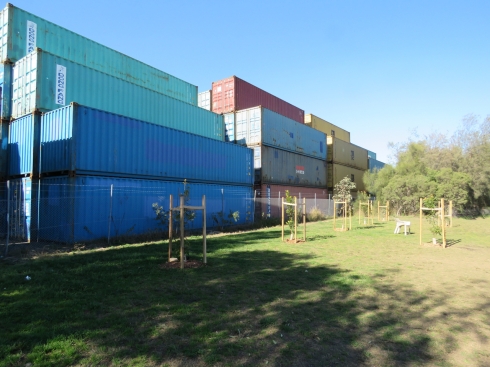
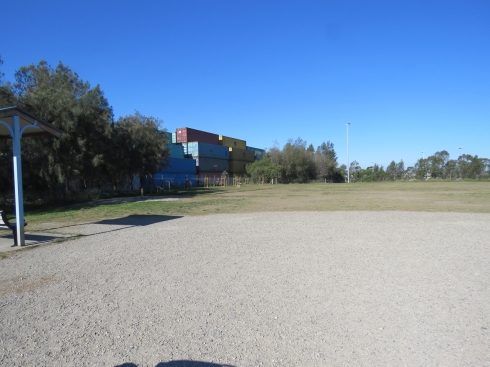
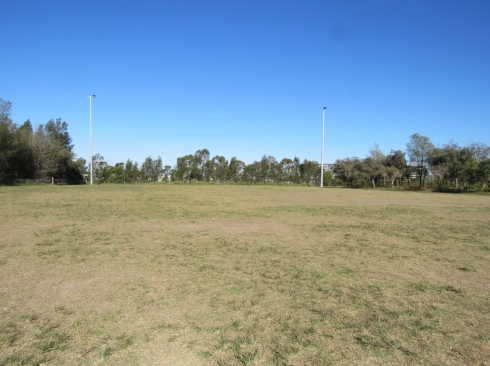
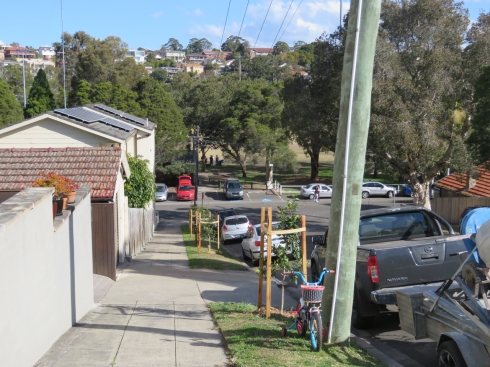



















Recent Comments